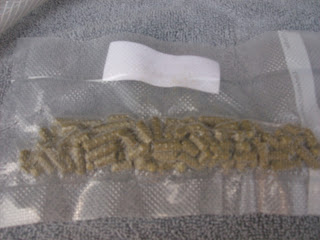2) Extract Brewing -- The process used by beginning home brewers.
3) All-Grain Brewing -- The full process which is used in breweries, but at home.
4) Production Brewing -- Some key differences between the experiences of home brewing and working in a microbrewery.
4) Production Brewing
Snapshot from a day at the brewery
Picture: [Lower Right] Filling kegs from the bright tank
[Right] CO2 tank pressurizing bright tank for keg filling because main tank ran out
[Center] Spent grains are being removed from mash tun using a hard rake into plastic containers
[Off Left] Cart used to run spent grains to grain trailer out back
As you'd expect, a production brewery does all the same basic things as an all-grain homebrewer. Below are some differences by topic.
Sanitation - This is the subject on which brewers are most picky, because it only takes one aggressive biological invader to ruin a batch of beer and the economic success of the brewery. In many breweries used implements and hoses are placed in a caustic soak, then moved to iodophor where they will remain until they are hosed off and used again. When handling the seals between fittings, make sure to keep your fingers on the outside, lest you contaminate the connection. It's successfully performing lots of little procedures like these which can ease the nerves of those who have let you into their brewery. I have heard of successful breweries which have, at one time or another, had to dump an entire batch of thirty or more barrels of brew and take the economic hit due to the tiniest of procedural overlookings.
Being Wet - Between cleaning and brewing you will have a lot of contact with water and other liquids. Towards the end of my summer with my last brewery I got a massive soaking in my boots of water and spent the last two weeks trying to dry them out and suffering for it. It's alright for all of you to be soaked except for your feet. On the average of once a summer I have accidentally sprayed myself with beer while filling kegs. Always check all of your valves and never allow yourself to engage your auto-pilot or you will get a hoppy hosing to the face. It's best to try to stay dry and accept it when you receive a dousing. At one of my breweries one of the brewers, thinking the large capacity hot liquor tank was empty opened the hatch and covered the floor of the brewery with a flood of 170F water.
Physical - When I showed up each summer at either of my breweries the guys there had become well conditioned to the physical strain of the job. I do not work a physical job the rest of the year and end up in pain for approximately two weeks until I have become acclimated to the requirements of the job. Like many other physical jobs, though, you just have to show up, work, ache, and wait for that third week. Most of the strain is attributed to tasks like moving full kegs of beer, handling 50 lb. sacks of grain, and removing the hot, soaked spent grains after the mash. Keep in mind a single batch for 15 bbl of beer can use 800 lbs. of grain and yield 30 160 lb. kegs. My first brewery brewed 30 bbl at a time. I regularly crawled into the emptied mash tun to clean it out while it was still well over 100F and extremely humid.
Good Company - In most areas of employment politics are ever present and difficult to avoid. While politics exist, one great thing about the brewing industry is that its workers tend to be easier to work with. In my opinion, people don't fall into a paid brewery job without first actually enjoying it. There are enough people who want to do it, so jerks don't tend to get hired. There are a lot of easier jobs out there which pay a lot more, so I'm sure that uninterested people don't even invest the incredible amount of effort to get in the door.
Danger - There are dangerous aspects of being in a brewhouse which need mentioning. There are going to be hot pipes near the brewing rig. At one brewery there is a pipe at ankle height which borders the platform on which you stand to look in the kettle. After a couple of nice marks I was able to remember to keep my distance. One common disaster in the brewhouse is reaching into a bucket to get a fitting when it wasn't sitting in iodophor or something relatively safe, but actually in an acidic cleaner. I've heard stories of skin being schluffed off of the arm where it was contacted by powerful cleaners. One quick fix is to open a small sampling valve on a fermentor and hose the area with beer. Oh yeah, everything's wet and kegs are heavy. Billy goats would do well here.
Adaptation - Unless you work for a huge fancy brewery, things will constantly occur with equipment and brewing processes. Boilers will need repair, drains will clog around the brewing rig, blow-off valves will function at the wrong PSI, the CO2 will run out, and some growlers will be made with unusually weak glass. Working in a brewery means being able to underatand the variables of the situation and manipulate them to keep the brew intact and delicious. Someone once said "Brewers are engineers and winemakers are farmers." I agree with the brewing side and suspect that winemakers are largely dependent on their ability to deal with the grapes pre-fermentation.
Cleaning - There's never downtime in brewing. There is cleaning. Kegs, the outside of fermentors, etc. Just as soon as you scrub and stack 50 kegs, 55 more show up. This involves using a keg washer system which is kind of neat. Kegs are loaded into the machine to be washed out, cleaned, sanitized, and purged with CO2. There's not a lot to say in this section, but it's a massive proportion of the work. hmm
It's a ton of work, but it's definitely worth it to sharpen up your skills and get into physical shape!




































